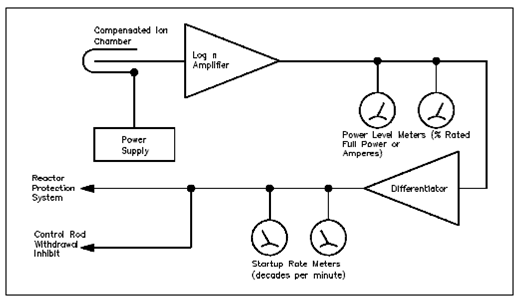Intermediate Range Nuclear Instrumentation:
There are three ranges are used to monitor the power level of a reactor by the full range of reactor operation. The intermediate range creates use of a compensated ion chamber.
Given a block diagram of a typical intermediate range instrument and STATE the reason of main components.
a. Log n amplifier
b. Differentiator
c. Reactor protection interface
Intermediate-range nuclear instrumentation consists of a minimum of two redundant channels. Every of these channels are made up of a boron-lined or boron gas-filled compensated ion chamber and related signal measuring equipment of that the outcome is a steady current generates through the neutron flux.
The compensated ion chamber is utilized within the intermediate range since the current outcome is proportional to the associatively stable neutron flux or it compensates for signals from gamma flux. This range of indication also gives a measure of the rate of change of neutron level. This rate of change is shown on meters in terms of startup rate in decades per minute (-1 to +10 decades per minute). A High startup rate on either channel might initiate a protective action. This protective action might be in the form of a control rod withdrawal inhibit and alarm, or a high beginning rate reactor trip.
Figure shows a typical intermediate-range channel.

Figure: Intermediate Range Channel
Typically, the compensated ion chamber outcome is an analog current ranging from 10-11 to 10-3 amperes, other than varies along with reactor design. The log n amplifier is a logarithmic current amplifier which converts the detector outcome to a signal proportional to the logarithm of the detector current. A logarithmic outcome is proportional to the logarithm of the neutron level.